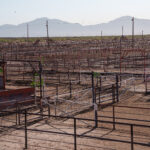Tropical Storm Emily broke apart over the mountains of Haiti and the Dominican Republic Thursday, but its remnants still packed rains threatening flash floods and mudslides in the neighboring Caribbean countries.
The U.S. National Hurricane Center said the storm dissipated into a low pressure trough, but cautioned it still had potential to regenerate.
The warning has prompted Florida’s authorities to continue their surveillance of the weather system to ensure thta it doesn’t re-strengthen into a threat to the state’s eastern coast.
The remnants of Emily, the fifth named storm of the 2011 Atlantic hurricane season, were stretched out across Hispaniola, the island shared by Haiti and the Dominican Republic and over the Turks and Caicos, at 8 p.m. EDT, the Miami-based center said.
The governments of the Dominican Republic, Cuba and the Bahamas have all dropped tropical storm watches and warnings after Emily weakened. But the hurricane center warned rainfall could still reach as much as 20 inches [50.8 cms] in some areas.
In an advisory late Thursday evening, the hurricane center also said there was a “high chance” that Emily’s remaining clouds and thunderstorms could redevelop into a tropical cyclone on Saturday.
“The large area of cloudiness and showers associated with this system is forecast to move northwestward toward the Bahamas at 10 to 15 mph [16 to 24 kph] for the next couple of days,” the center said.
Heavy rainfall is a significant threat to Haiti, which is vulnerable to flash floods and landslides because of its near-total deforestation. In June, at least 23 people were killed after rains unleashed flooding and mudslides.
Occasional light rains fell on Thursday in the sprawling, mountain-cradled Haitian capital of Port-au-Prince, where more than 600,000 survivors of the 2010 earthquake still live in fragile tent and tarpaulin camps.
Haitian President Michel Martelly and civil defense officials had issued public appeals for those living in low-lying or flood-prone areas of the hilly, quake-damaged capital to move to safer areas and not wait to be evacuated.
Emily posed no threat to oil and gas production facilities in the U.S. Gulf of Mexico. Some tracking forecasts had earlier showed it crossing the Bahamas and possibly approaching Florida by the weekend.
On Thursday, NOAA raised its outlook for activity in the 2011 Atlantic hurricane season, predicting it would produce seven to 10 hurricanes.
Three to five of those were expected to strengthen into “major” hurricanes of Category 3 or higher on the five-step Saffir-Simpson intensity scale, with top winds of at least 110 miles per hour [176 kph], it said. In May the NOAA projected six to 10 hurricanes.
(Additional reporting by Pascal Fletcher and Jane Sutton in Miami; Writing by Kevin Gray; Editing by Pascal Fletcher and Eric Beech)
Topics Catastrophe Natural Disasters Flood Windstorm Hurricane
Was this article valuable?
Here are more articles you may enjoy.


 Former CEO of Nonprofit P/C Statistical Agent Sentenced for Stealing Millions
Former CEO of Nonprofit P/C Statistical Agent Sentenced for Stealing Millions  Catastrophe Bonds Linked to Wildfires Lose ‘Untouchable’ Status
Catastrophe Bonds Linked to Wildfires Lose ‘Untouchable’ Status  Brown & Brown Files Suit Over Alleged Howden Poaching of 200+ Employees
Brown & Brown Files Suit Over Alleged Howden Poaching of 200+ Employees  More US Beef Plants May Close as Cattle Herds Keep Tightening
More US Beef Plants May Close as Cattle Herds Keep Tightening 

